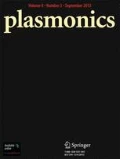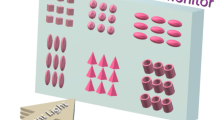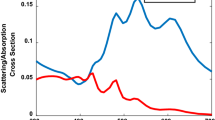Abstract
A transparent display allows us to see both the projection image displayed on it and the view behind it at the same time, which can be widely used in the car windshield, shop windows, and so on. To achieve the transparent display with the simple and easily available plasmonic nanoparticles, plasmonic Au-Ag nanoparticles with the strong scattering ability were used to achieve the objective of selectively scattering red, blue, and green light for the transparent screen in this work. Firstly, the optimized size parameters for these three color transparent displays were obtained theoretically. On the other hand, plasmonic nanoparticles used for the blue and green color transparence screen were reported in the previous experiments. Finally, a red color transparent display with the wide viewing angle was made based on the optimized Au nanoparticles experimentally.






Similar content being viewed by others
References
Rycenga M, Cobley CM, Zeng J, Li W, Moran CH, Zhang Q, Qin D, Xia Y (2011) Controlling the synthesis and assembly of silver nanostructures for plasmonic applications. Chem Rev 111:3669–3712. https://doi.org/10.1021/cr100275d
Song M, Li X, Pu M, Guo Y, Liu K, Yu H, Ma X, Luo X (2018) Color display and encryption with a plasmonic polarizing metamirror. Nanophotonics 7:323–331. https://doi.org/10.1515/nanoph-2017-0062
Rezaei SD, Hong Ng RJ, Dong Z, Ho J, Koay EHH, Ramakrishna S, Yang JKW (2019) Wide-gamut plasmonic color palettes with constant subwavelength resolution. ACS Nano 13:3580–3588. https://doi.org/10.1021/acsnano.9b00139
Li H, He Y, Wang X, Liu D, Liu Z (2019) Bilayer films using broadband nanoparticles and mesoporous TiO2 for high efficient dye sensitized solar cells. J Alloys Compd 773:743–751. https://doi.org/10.1016/j.jallcom.2018.09.279
Chen M, He Y, Zhu J, Wen D (2016) Investigating the collector efficiency of silver nanofluids based direct absorption solar collectors. Appl Energy 181:65–74. https://doi.org/10.1016/j.apenergy.2016.08.054
Chen M, He Y, Zhu J, Shuai Y, Jiang B, Huang Y (2015) An experimental investigation on sunlight absorption characteristics of silver nanofluids. Sol Energy 115:85–94. https://doi.org/10.1016/j.solener.2015.01.031
Huang J, He Y, Chen M, Jiang B, Huang Y (2017) Solar evaporation enhancement by a compound film based on Au@TiO2core–shell nanoparticles. Sol Energy 155:1225–1232. https://doi.org/10.1016/j.solener.2017.07.070
Wang X, He Y, Chen M, Hu Y (2018) ZnO-Au composite hierarchical particles dispersed oil-based nanofluids for direct absorption solar collectors. Sol Energy Mater Sol Cells 179:185–193. https://doi.org/10.1016/j.solmat.2017.11.012
Chen M, He Y, Zhu J (2019) Quantifying and comparing the near-field enhancement, photothermal conversion, and local heating performance of plasmonic SiO2@Au core-shell nanoparticles. Plasmonics 14:1019–1027. https://doi.org/10.1007/s11468-018-0889-x
Chen M, Mandal J, Ye Q, Li A, Cheng Q, Gong T, Jin T, He Y, Yu N, Yang Y (2019) A scalable dealloying technique to create thermally stable plasmonic nickel selective solar absorbers. ACS Appl Energy Mater 2:6551–6557. https://doi.org/10.1021/acsaem.9b01112
Chen M, He Y (2018) Plasmonic nanostructures for broadband solar absorption based on the intrinsic absorption of metals. Sol Energy Mater Sol Cells 188:156–163. https://doi.org/10.1016/j.solmat.2018.09.003
Song M, Wang D, Peana S, Choudhury S, Nyga P, Kudyshev ZA, Yu H, Boltasseva A, Shalaev VM, Kildishev AV (2019) Colors with plasmonic nanostructures: a full-spectrum review. Appl Phys Rev 6:041308. https://doi.org/10.1063/1.5110051
Hail CU, Schnoering G, Damak M, Poulikakos D, Eghlidi H (2020) A plasmonic painter’s method of color mixing for a continuous red-green-blue palette. ACS Nano 14:1783–1791. https://doi.org/10.1021/acsnano.9b07523
Song M, Kudyshev ZA, Yu H, Boltasseva A, Shalaev VM, Kildishev AV (2019) Achieving full-color generation with polarization-tunable perfect light absorption. Opt Mater Express 9:779. https://doi.org/10.1364/ome.9.000779
Chen M, He Y, Hu Y, Zhu J (2019) Local heating control of plasmonic nanoparticles for different incident lights and nanoparticles. Plasmonics 14:1893–1902. https://doi.org/10.1007/s11468-019-00990-1
Ebrahimpour Z, Mansour N (2018) Plasmonic near-field effect on visible and near-infrared emissions from self-assembled gold nanoparticle films. Plasmonics 13:1335–1342. https://doi.org/10.1007/s11468-017-0637-7
Byun S, Yong Lee H, Yoo J (2014) Systematic approach of nanoparticle design to enhance the broadband plasmonic scattering effect. J Appl Phys 115:184302. https://doi.org/10.1063/1.4875660
Kivanc Hedili M, Freeman MO, Urey H (2013) Microlens array-based high-gain screen design for direct projection head-up displays. Appl Opt 52:1351–1357. https://doi.org/10.1364/AO.52.001351
Hsu CW, Zhen B, Qiu W, Shapira O, DeLacy BG, Joannopoulos JD, Soljačić M (2014) Transparent displays enabled by resonant nanoparticle scattering. Nat Commun 5:1–6. https://doi.org/10.1038/ncomms4152
Saito K, Tatsuma T (2015) A transparent projection screen based on plasmonic Ag nanocubes. Nanoscale 7:20365–20368. https://doi.org/10.1039/c5nr06766a
Ye Y, Chen T, Zhen J, Xu C, Zhang J, Li H (2018) Resonant scattering of green light enabled by Ag@TiO2 and its application in a green light projection screen. Nanoscale 10:2438–2446. https://doi.org/10.1039/c7nr07383f
Zhao J, Pinchuk AO, Mcmahon JM et al (2008) Methods for describing the electromagnetic properties of silver and gold nanoparticles. Chem Soc Rev 41:1710–1720
Johnson P, Christy R (1974) Optical constants of transition metals: Ti, V, Cr, Mn, Fe, Co, Ni, and Pd. Phys Rev B 9:5056–5070. https://doi.org/10.1103/PhysRevB.9.5056
He Y, Chen M, Wang X, Hu Y (2018) Plasmonic multi-thorny gold nanostructures for enhanced solar thermal conversion. Sol Energy 171:73–82. https://doi.org/10.1016/j.solener.2018.06.071
Chen M, He Y, Ye Q, Wang X, Hu Y (2019) Shape-dependent solar thermal conversion properties of plasmonic Au nanoparticles under different light filter conditions. Sol Energy 182:340–347. https://doi.org/10.1016/j.solener.2019.02.070
Zeman EJ, Schatz GC (1987) An accurate electromagnetic theory study of surface enhancement factors for silver, gold, copper, lithium, sodium, aluminum, gallium, indium, zinc, and cadmium. J Phys Chem 91:634–643. https://doi.org/10.1021/j100287a028
Ru EC Le Etchegoin PG (2009) Principles of surface-enhanced Raman spectroscopy and related plasmonic effects. Elsevier Ltd 1–656. https://doi.org/10.1016/B978-0-444-52779-0.00003-9
Chen M, He Y, Huang J, Zhu J (2016) Synthesis and solar photo-thermal conversion of Au, Ag, and Au-Ag blended plasmonic nanoparticles. Energy Convers Manag 127:293–300. https://doi.org/10.1016/j.enconman.2016.09.015
Shankar SS, Rai A, Ahmad A, Sastry M (2004) Rapid synthesis of Au, Ag, and bimetallic Au core-Ag shell nanoparticles using Neem (Azadirachta indica) leaf broth. J Colloid Interface Sci 275:496–502. https://doi.org/10.1016/j.jcis.2004.03.003
Haldar KK, Kundu S, Patra A (2014) Core-size-dependent catalytic properties of bimetallic Au/Ag core-shell nanoparticles. ACS Appl Mater Interfaces 6:21946–21953. https://doi.org/10.1021/am507391d
Funding
This work was financially supported by the Central South University.
Author information
Authors and Affiliations
Corresponding author
Additional information
Publisher’s Note
Springer Nature remains neutral with regard to jurisdictional claims in published maps and institutional affiliations.
Rights and permissions
About this article
Cite this article
Chen, M., Yan, H., Zhou, P. et al. Transparent Display by the Scattering Effect of Plasmonic Au-Ag Nanoparticles. Plasmonics 15, 1855–1861 (2020). https://doi.org/10.1007/s11468-020-01194-8
Received:
Accepted:
Published:
Issue Date:
DOI: https://doi.org/10.1007/s11468-020-01194-8




